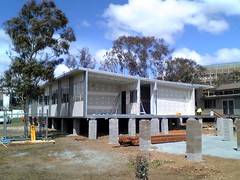
One of the studio units in the Australian National University
Laurus Wing of Ursula Hall was
open for inspection, so I went along to have a look. I was expecting something which looked like a stack of containers, but this instead is a modern, elegant and very solid apartment building.
The outside finish and balcony panels had not yet been applied to the building, so the framework of containers was apparent. The joins between the container are being covered to make them appear to be solid columns and beams. The ends of the containers are being filled with coloured glass panels. There is an open welded steel fire stair at one end of the building and a concrete service core at the other end. This sounds very utilisation, but looks much better in reality.
The apartment for inspection was on the ground floor. The first impression, like the building is of solidity: the door is double glazed frosted glass and appears very solid. Next to the door is the access panel to the riser for plumbing (a section has been cut out of the top and bottom of each container to provide easy access for the plumbing). Inside the front door is a small vestibule. There is then the bathroom on the left and a hallway. The bathroom is small but makes good use of the space with a reasonably sized shower. There is then a small kitchen on the left. The kitchen has a single small sink and a very small two plate stove-top in the bench. There is limited cupboard space but a a full size refrigerator. A better option might be to install a smaller bar fridge and put a microwave oven in the space freed up above this. The kitchen is more than adequate with good quality but robust finish.
Next to the kitchen is very small hanging space which might fit one coat and one pair of trousers. While students might not be expected to dress up for the office each day, this seems inadequate (there are coat hooks next to the front door as well). coat hanger is a generous student desk. Perhaps the desk could be smaller to make room for more clothes (with some sort of fold up extension on the desk). Students will be increasingly using online study materials, with less need of desktop space for books.
Next to the desk is a built in bed. The bed looks out on the balcony and with the coloured glass panel installed under the balcony railing will provide a view with privacy. There are large drawers built under the bed and open shelves above, providing most of the storage for the apartment. The wall shelves might have looked better with doors on them., but this would have made the space look smaller.
The bed is fixed and takes up a lot of floor space. It would be tempting to have some sort of folding or sofa bed, but in reality these tend to be left open in everyday use and the mechanisms tend to break. However, perhaps there could be a simple fold down panel to extend the student desk over the bed and some bolsters at the back to make the bed more comfortable to sit on.
A flat screen TV is mounted on an arm on the wall opposite the bed. This can be swung out so the TV can be seen from the bed, kitchen or balcony. This intrudes into the limited space between the bed and wall, making an already narrow space look narrower. I would have preferred the flat screen mounted at the desk, so it could be used as a computer screen with a laptop as well as a TV. However, this would then require lying the other way in bed to see the TV (not that watching TV in bed is a good idea anyway). There may be some other creative solutions to this, such as a small TV attached to the wall above the bed, or a LED/LCD projection unit on the ceiling projecting onto the wall or onto the blind over the window.
At the far end of the apartment is a small balcony. No doubt that these will soon become filled with bicycles and other items, as is common with student accommodation, but it looks a comfortable space to relax and will help shade the apartment from the afternoon sun. In other situations, the coloured glass panels on the balcony might be replaced with perforated metal panels. These would be more robust and could be shaped to allow precise control of the sunlight (admitting it in winter and blocking it in summer) and vision (providing a view for the occupants and privacy).
Quicksmart Homes have made the most of the limitations of the
ISO standard forty foot shipping container modules. The apartments still look a little narrow, but livable and stylish. This should do much to dispel the idea that modular buildings are low status, temporary and flimsy constructions.
Labels: accommodation, ANU, Architecture, Canberra, ISO, modular building, Shipping Container



















